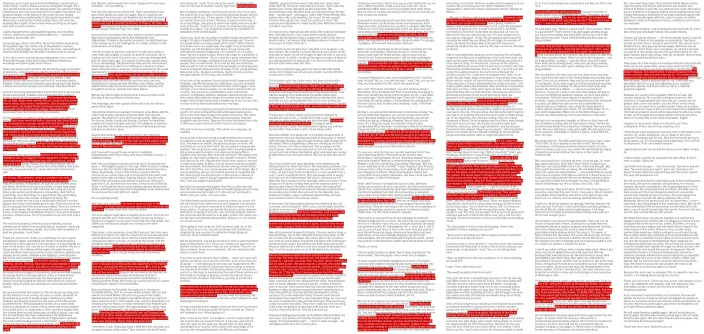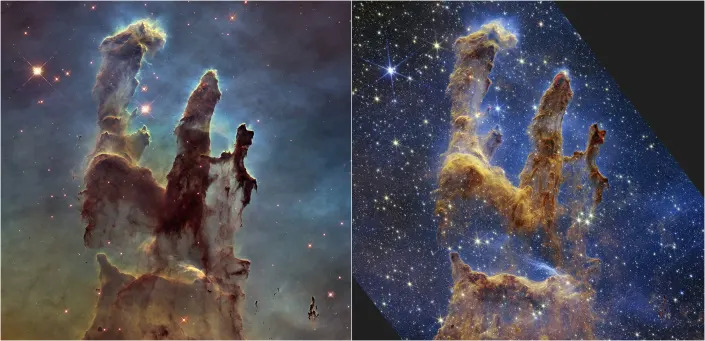In Announcing 2024 Bid for Presidency, Trump Echoes Old Falsehoods
Linda Qiu
Thu, November 17, 2022

The text of Donald Trump's announcement of His 2024 run.
WASHINGTON — Former President Donald Trump announced his third bid for the presidency Tuesday night in a speech that was like many others that have come before it: packed full of falsehoods.
Trump uttered the first inaccurate claim about two minutes in: that his administration “built the greatest economy in the history of the world.” That was inaccurate even for recent American history. Annual average growth, even before the coronavirus pandemic decimated the economy, was lower under Trump than under Presidents Bill Clinton and Ronald Reagan.
Two minutes later, he ticked off at least four hyperbolic statements about his accomplishments as president. He pointed to drugs coming across the border at “the lowest level in many, many years.” (The total flow of drugs is unknowable.) He claimed to have “finally attained the impossible dream of American energy independence.” (Before Trump took office, the country had been projected to become a net exporter of energy, and it still relies on some imports.) He said that “no president had ever sought or received one dollar for our country from China,” which handed over “hundreds of billions of dollars” under his administration. (His tariffs on Chinese imports have so far raised $161 billion, with much of those tariffs passed onto consumers, and duties had been placed on Chinese imports before he took office.) And he repeated his perennial falsehood of delivering “the biggest” tax cuts in American history. (Several others were larger.)
Over the next hour, Trump repeated many familiar exaggerations about his own achievements, reiterated misleading attacks on political opponents and made dire assessments that were at odds with reality.
Here’s a fact-check of some of his remarks:
The Economy and Energy Policy
In Trump’s telling, he had made America “great and glorious” and President Joe Biden “destroyed it.” Not content with accurately pointing out that inflation had soared in recent months to the highest point in decades and gas prices had broken records, Trump embellished even more.
He added: “I expect them to go higher, now that the strategic national reserves, which I filled up, have been virtually drained.”
Trump did not completely fill up the Strategic Petroleum Reserve, nor has Biden almost emptied it. Since the first oil was delivered to the stockpile in 1977, it stored the most oil under President Barack Obama, about 726 million barrels. Under Trump, the amount fluctuated between 634 million and 695 million barrels. Under Biden, it has fallen to about 445 million barrels in August, the month with the most recent figures.
“We will immediately tackle inflation and bring down to a level where it was: We were at zero,” Trump claimed.
The Consumer Price Index was at 1.2% in 2020, the last full year he was in office, and 1.4% in January 2021, his last month as president.
“We were $1.87 a gallon for gasoline. Now it is sitting at $5, $6, $7 and even $8,” Trump exaggerated. “The socialist disaster known as the Green New Deal, which is destroying our country, and the many crippling regulations that it has spawned will be immediately terminated so that our country can again breathe and grow.”
Nationally, the average price for gas was $2.39 a gallon in the last week of January 2021. Last week, it was $3.76. The Green New Deal is a proposal by some Democrats in Congress to tackle climate change, and has not been enacted into law.
Immigration and Border Security
Much as he did in his speech announcing his presidential bid seven years earlier, Trump devoted considerable time to discussing border security.
Several times, he falsely heralded the completion of his long-promised border wall. The Trump administration constructed 453 miles of border wall over four years, and a vast majority of the new barriers reinforced or replaced existing structures. Of that, about 47 miles were new primary barriers. The United States’ southwestern border with Mexico is over 1,900 miles.
“When the wall was finished, that’s how we set all these records,” he claimed.
Apprehensions of unauthorized border crossers had decreased in the 2020 fiscal year, Trump’s last full year in office, to about 400,000. That decline was not because of an incomplete physical wall, but in part because of his hard-line immigration policies and in part because migration and travel had dipped in light of the pandemic. Nor were those figures the lowest recorded. The 2016 and 2015 fiscal years yielded similar numbers: 400,000 and 331,000.
Those figures have increased sharply under Biden to more than 2.3 million in the 2022 fiscal year, breaking records. But an accurate comparison was not stark enough for Trump, who inflated the numbers even more.
“It’s 10 million people coming in, not 3 or 4 million people; they are pouring into our country. We have no idea who they are and where they come from. We have no idea what is happening to our country,” he said, offering no evidence.
Foreign Policy
Trump made several assessments about global conflicts and geopolitics that required further scrutiny.
The Islamic State extremist group, he said, “was decimated by me.” The group suffered territorial losses in 2019, but analysts and Trump’s own military officials warned that ISIS fighters remained an insurgent force in the country. Just last month, U.S. Special Forces carried out major strikes against the group.
Russia’s invasion of Ukraine “never would have happened if I were your president,” he declared. “Just today, a missile was sent in probably by Russia to Poland, 50 miles into Poland.”
This statement, cautious by Trump’s standards, nonetheless contained an exaggeration. At the time of his remarks, Poland had said a missile most likely made by Russia had killed two citizens about 4 miles — not 50 — from its border with Ukraine, but Poland’s president said there was no conclusive evidence. By Wednesday, Poland and NATO had said the missile was more likely a Ukrainian air defense missile and characterized the explosion as an accident.
Trump also mocked the Biden administration’s and other world leaders’ focus on climate change: “They say the ocean will rise 1/8th of an inch over the next 200 to 300 years.” Sea level along the U.S. coastline is projected to rise by 10 to 12 inches in the next 30 years alone.
Attacks on Trump Investigations
As he often does during campaign rallies, Trump used misleading claims to portray himself as the victim of what he described as corrupt investigations by the FBI and the Justice Department.
“The FBI offered $1 million to Christopher Steele, who wrote the fake dossier, if he will lie and say that the fake dossier was true,” Trump said. “And he refused to do it, so it had to be really fake.”
The bureau offered Steele, a British former spy who compiled a salacious dossier of unproven rumors about Trump’s ties to Russia, up to $1 million if he could prove those allegations, an FBI analyst testified in court in October. Steele could not and did not receive the money.
“And then they hired somebody, Danchenko, for $200,000 a year, to focus on Trump and to get Trump and other things, including the raid of a very beautiful house that sits right here,” he added. “The raid of Mar-a-Lago, think of it.”
He was referring to Igor Danchenko, a Russian analyst who provided much of the research for the dossier. Danchenko was recently acquitted on four counts of lying to the FBI about his sources, in an investigation examining the origins of the inquiry into Trump’s ties with Russia. During Danchenko’s trial, an agent testified that the FBI had paid him $200,000 over three years — not one, as Trump said — for his work as a confidential source.
Moreover, Danchenko’s trial and the investigation that spurred it had nothing to do with the FBI’s search of Mar-a-Lago, Trump’s home and private club in Florida. That court-ordered search was focused on retrieving government documents, some classified and marked top secret, that Trump took from the White House and stored there.
“Why didn’t you do Obama, who took a lot of things with him?” Trump continued.
But unlike Trump, former President Barack Obama had not kept documents and instead turned them over to National Archives and Records Administration, as required by a 1978 law.
Election Results
The outcome of the midterm elections and the fact that the Republican Party fell short of expectations were almost an afterthought to Trump.
He claimed premature victory, saying Republicans took a majority in the House of Representatives “just a short time” before his speech though the party was only on the verge of taking control. The race was officially called for Republicans on Wednesday night.
Though Trump refrained from repeating his bogus claims of outright electoral fraud, he still complained about the voting process, which he characterized as “a ridiculously long and unnecessary period of waiting, far longer in fact than any third-world country.”
Trump singled out France, where President Emmanuel Macron won reelection in April. Trump was largely correct that the first projections declaring Macron the winner occurred shortly after the last polling locations closed at 8 p.m. But the relative speed of that call, compared with the first projections of the midterm elections in the United States, can be attributed to the more straightforward election process in France. It was a single race compared with multiple local and state-level races on the ballots in the United States; was administered by a centralized authority, the Interior Ministry, rather than by local election officials under different rules and procedures; and occurred across a single time zone, rather than multiple ones, as in the United States.
Moreover, he is wrong that the United States takes longer than “any” country to count votes. In recent presidential elections, Indonesia took more than a month to count the votes in 2019, Afghanistan five months to declare a winner after its September 2019 vote, and Bosnia weeks to declare a winner this fall.
Trump also briefly defended his position as kingmaker: “I do want to point out that in the midterms, my endorsement success rate was 232 wins and only 22 losses.”
Left unsaid: Many of those 200-or-so victories came in deeply conservative districts where Republicans were expected to easily win reelection. In 114 districts where the margin of victory was less than 15%, candidates endorsed by Trump underperformed their baseline by 5 percentage points, according to Philip Wallach, a fellow at the conservative American Enterprise Institute. An analysis from the Upshot showed a similar result.
And Trump reminisced over past electoral successes, exaggerating again when he claimed to have “won every single area along the borders” in Texas. (In reality, he won seven out of 14 border counties in the state in 2020 and five in 2016.)
“In 2020, I received the largest number of votes of any sitting president in history,” Trump recounted, ignoring that Biden had even more votes.
© 2022 The New York Times Company















